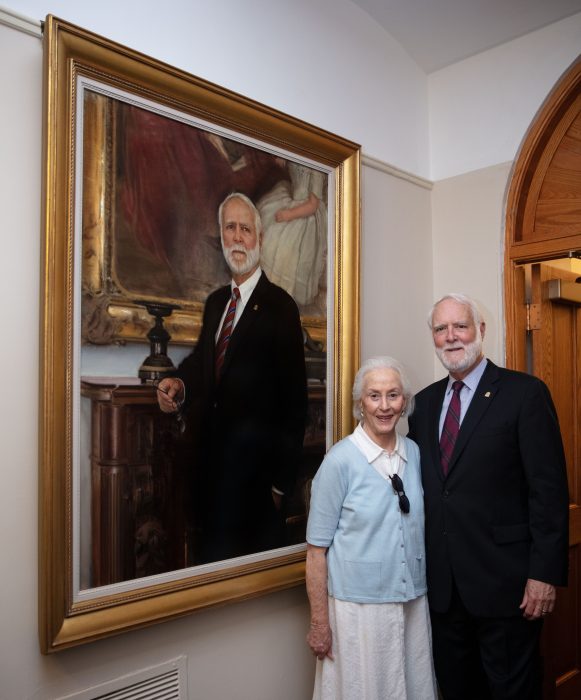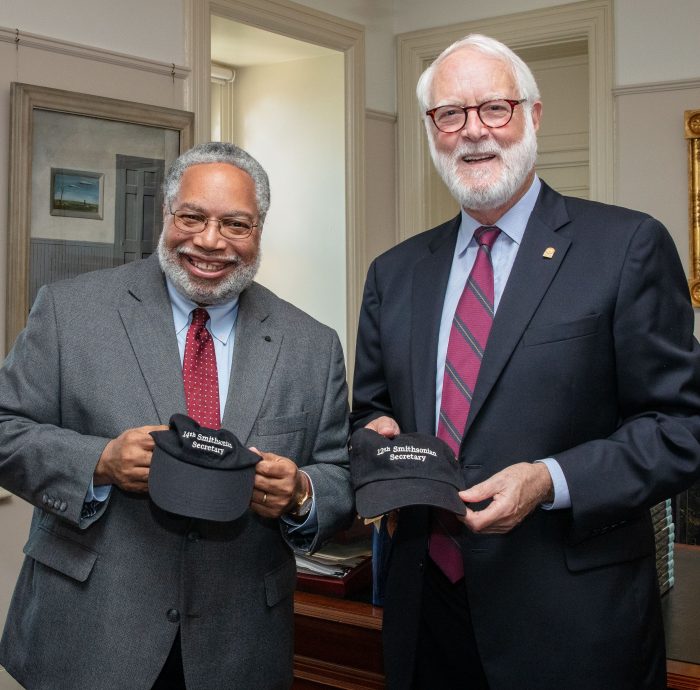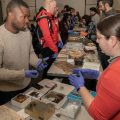A striking likeness
Dr. Wayne Clough, 12th Secretary of the Smithsonian visited the Castle June 19 for the unveiling of his official portrait. Torch spoke to artist Ronald Sherr about the challenges of capturing a likeness that lives.

Former Smithsonian Secretary Wayne Clough and Anne Clough stand next to his official portrait at its unveiling June 19, 2019. (Photo by Jaclyn Nash)
Dr. Clough served as Smithsonian Secretary from 2008 to 2015. During his tenure, he Clough established a strategic plan with four main themes that would guide the Smithsonian’s work in the coming years. He put a new emphasis on education and digital technology, envisioning the Smithsonian as a national forum for informal education. He worked to make the Smithsonian a relevant part of people’s lives through innovative educational outreach programs, support and promotion of hundreds of global scientific research projects and collaboration with universities and cultural organizations on everything from saving endangered species to preserving artwork destroyed in a natural disaster.
He oversaw several major openings at the Smithsonian, including the David H. Koch Hall of Human Origins and the Sant Ocean Hall at the National Museum of Natural History. Construction of the National Museum of African American History and Culture began in 2012, and it opened in September 2016.
He was succeed by Albert Horvath (Acting, January 2015–June 2015); David J. Skorton (July 2015–June 2019) and Lonnie Bunch III, (June 16, 2019 – Present.)

14th Smithsonian Secretary Lonnie Bunch and 12th Secretary Wayne Clough show off their Secretarial baseball caps. (Photo by Jaclyn Nash)
Each Smithsonian Secretary is honored with an official portrait commissioned by the National Portrait Gallery that joins his or her predecessors on display in the Smithsonian Castle. “We prepare a portfolio of several artists for the Secretary to choose from,” explained Brandon Fortune, chief curator at NPG. “We make recommendations guided by the Secretary’s taste and preferences, but they ultimately choose the artist. The Board of Regents raises the funds to pay for the portrait and the finished work is accessioned by the Portrait Gallery.”
Dr. Clough selected artist Ronald Sherr for his own portrait. Sherr’s paintings of notable Americans include former presidents, Supreme Court justices, senators and governors as well as leaders in business, medicine, academia and the arts. His portraits of General Colin Powell and of President George H. W. Bush, commissioned by the Portrait Gallery, are part of the Smithsonian’s collections.
Torch recently had the opportunity to speak with Sherr about the process of capturing a likeness that will continue to have life long after its subject is gone.
What is your general approach to painting a portrait? Do you work from life?
Ronald Sherr: While I began my career in portraiture working exclusively from life, I slowly came to realize that I would have an extremely limited clientele if I held firm and continued in that way (in fact, I lost several high profile commissions early on as I didn’t even own a camera). At the time, I required anywhere from 20 to 50 three-hour sittings for a life size/three-quarter portrait. Now, while I still prefer to work from life whenever possible, things are quite different considering nearly all of my commissions still come from the States—yet I’ve been living in Asia for the past 12 years. Hence, I use photographs in order to reduce the number of sittings (which vary depending on the size and complexity of the portrait). Sittings consist of both sketching and photography.
My procedure is to develop a full-scale drawing of the subject (or at the very least, a head and shoulders), and numerous smaller sketches of background elements, perspective and color studies, etc., that are usually accomplished in three to six sittings. The larger drawing is subsequently transferred to canvas or wood panel and the painting begun using the studies, color notes, photographs and memory as reference.
How do you capture a personality as well as a likeness?
To me, that’s the most difficult part—and impossible to describe adequately. It’s about working for a feeling of the sitter and not just a literal representation. Truthfully, I just keep picking away at a portrait until the subject in the painting sort of smiles back at me. That’s when I know the person is “there” (which can happen on and off as a painting progresses—with no guarantee that he or she will still be “there” in the end.). The great Italian portrait painter to Queen Elizabeth II, Pietro Annigoni, describes this phenomenon as the “third” person in the work… artist, sitter, and the person coming to life in the portrait. In the best portraits, that third person is alive and looking back at you, and it always seems to me that it’s just luck or magic that somehow makes it happen.
Did this particular painting (Dr. Clough) present any unusual challenges?
Honestly, every portrait is difficult challenge… bar none. Each one presents a different problem requiring a different solution. I suppose the only thing I beat myself up over in this one, however, was the fact that Dr. Clough has a wonderful smile and a warm, jovial personality—but I really didn’t envision his portrait to be that kind of painting. He posed for me first at the Smithsonian and then later came to my studio in New York, where I made a life-size drawing of him and numerous other sketches of specific details. It was a rather dark, overcast day and he happened to have a more serious countenance which I thought to be very interesting. Considering the scope of the Secretary’s job and the myriad, fascinating stories he had told me of his tenure as Secretary, I decided on the more serious look for the portrait. I must also add that I found Dr. Clough to be an incredibly interesting and accomplished man; one of the most enjoyable people I have ever had the pleasure to work with.
Dr. Clough is posed in the Regents Room (I notice the painting of the Hough family in background.) Was this a deliberate “infinity mirror” reference to the fact that portraits have traditionally hung there or just a happy coincidence?
Pretty much a happy coincidence. When he stood in front of the Hough family painting, I knew immediately that was going to be the winning pose. The trouble was that the Regent’s Room has a very large table in the center of the room (much too large for us to move) and it was right smack in the way of where I needed to be to take my photos. So, with Dr. Clough’s permission, I climbed up onto the table and struggled (at 60-some years of age, sprawled out on my side and in my suit) to get the photos I wanted. (Ed. note: We won’t tell Richard Stamm, the Castle curator.)
Do the subjects get “final approval” over the work? Has it ever happened that someone hated their portrait? How does the process of collaboration work?
Yes, to the first and no, to the second. I often send progress photos along the way so there are no surprises in the end. If there are any particular areas that a client may want me to address, we will discuss, and I will go from there. I also have a rule that I will not make any changes to a picture that a client would like me to do—unless I think I can make an even better painting.
Dr. Clough’s portrait, along with those of other Smithsonian Secretaries, is on view on the second, floor, East Wing of the Smithsonian Castle.
Posted: 24 June 2019
-
Categories:
Administrative News , Art and Design , Feature Stories , History and Culture , News & Announcements







